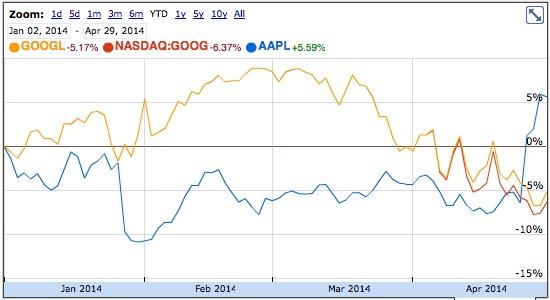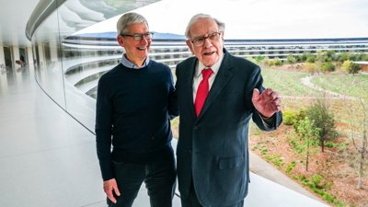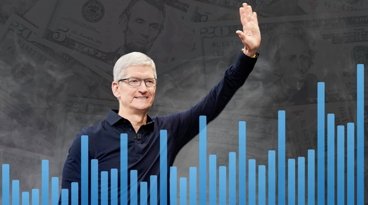After announcing its 7-1 stock split, Apple also outlined why it did so, answering in advance the oft-raised question with a simple answer: "We want Apple stock to be more accessible to a larger number of investors."
Apple didn't frame its statement to suggest a specific type of investor it was hoping to make its stock "more accessible to," but there are a couple reasons why a split would attract different types of buyers.
Institutional investors
Institutional buyers, including mutual funds and other banking institutions, may have rules related to the maximum price of the shares they hold. By splitting its stock into a fraction that causes the share price to align with the rules of a greater swath of these buyers, Apple increases the number of potential buyers.
Research by Morgan Stanley analyst Katy Huberty from February indicated that the proportion of institutional ownership in Apple is at a five year low.
As a trend, that suggests that Apple's rapidly rising stock price may have been a problem for institutional investors. The advantage of attracting institutional buyers (beyond the value of having buyers at all) is that they are seen as having an attractive influence.
Many funds effectively market themselves and their stock picks as something others should emulate, out of their own self interest because advertising their holdings can attract new buyers who will help drive up the prices of the securities it holds.
Individual investors
For individual investors, the psychology of a lower per-share price and greater number of shares might simply feel like a better deal, although, of course, the split has no direct impact on value.
The idea that Apple might be interested in individual investors is reflected in the wording of the very simple example it presented to explain that the stock split doesn't change the actual value of an investor's overall holdings.
"Let's assume that as of the Record Date (June 2, 2014) an investor owns 100 shares of Apple common stock and that the market price of Apple stock is $490 per share, so that the investment in Apple is worth $49,000," Apple stated on the subject.
"Let's also assume that Apple's stock price doesn't move up or down between the Record Date and the time the split actually takes place.
"Immediately after the split, the investor would own 700 shares of Apple stock, but the market price would be $70 per share instead of $490 per share. The investor's total investment value in Apple would remain the same at $49,000 until the stock price moves up or down."
A split does offer more future flexibility in selling a fraction of one's holdings, the same way having quarters rather than a dollar coin allows a person to only pay for a short period when parking at a meter. As Apple's shares head upward, having to sell $600 to $1000 of stock at once might be less flexible than a small investor would like.
A fresh start
In the past, Apple has split its shares 2-1, first in 1987, then again in 2000 and 2005. The more typical 2-1 split cuts the price neatly in half, which is really easy math. Splitting by 7 is a less familiar transformation, which may have been intentionally selected to reset the market's expectations of where Apple "should" be trading.
After a two year period of irrational stock moves, Apple may likely want to erase the mental barriers investors may have about where Apple trades, as well as breaking any psychological links between Apple's share price and that of other companies one might compare it against.
Dividing the stock price by 7 results in an entirely new set of numbers that aren't easy to mentally translate in comparisons with past expectations. This is similar to how a tourist— in a country where the local currency is an unfamiliar fraction of the value of the currency his expectations are set in— now looks at prices in a new way.
The seven way split certainly explains why Apple chose an odd number for its new dividend: $3.29 is Apple's first dividend to be evenly divisible by seven, resulting in 47 cents.
The psychological barrier of $700, the price Apple hit in late 2012 before a series of drops that reached below $400, resonates in the minds of many current and former Apple shareholders. Splitting by 7 turns that memorable number into $100, which doesn't seem particularly difficult to attain at all, simply because it sheds the trappings of historical context.
Erasing Google comparisons
In particular, Apple reached $700 around the same time Google did. However, as Apple's stock has tumbled into oblivion in 2013, Google's has blown into the stratosphere, reaching above $1100 before Google itself performed a split of sorts.
Google's split does not appear to have been an attempt to court new investors, because it wasn't just a 2-1 split. It was a "dividend" adjustment, where Google took its $1100 stock back and gave its existing shareholders two shares valued at half the price each.
What makes Google's move unlike a standard split is that one of the shares has no voting rights. Google's split was designed to silence shareholder input by taking away their rights in exchange for nothing. The move also created two different, independently valued classes of Google stock trading under different ticker symbols: GOOG and GOOGL.
With a 7-1 split, Apple's share price at Monday's close would be $84.87, a figure that is harder to compare against Google's price than the current "half of double of Apple at its peak."
Apple's stock hasn't been around $80 since the opening of the iOS App Store in 2008, back in the days when investors were driving Apple's stock up and down between $180 and $80 as everyone shared their doubts about the new iPhone and its iTunes App Store.
Psychologically, that resets the 2014 Apple stock clock to point where investors can imagine another four year long appreciation in value, without being distracted by the last two years' reminder of a bandwagon of investment in Google as investors scurried away from Apple's profitability to instead fund Google's breathtakingly expensive $12.5 billion acquisition in Motorola Mobility, cover all of its subsequent billions in operational losses, and take on accountability for Samsung's patent infringement via a secret indemnification agreement that even Samsung didn't want anyone to know about.
 Daniel Eran Dilger
Daniel Eran Dilger








-m.jpg)






 Charles Martin
Charles Martin
 Christine McKee
Christine McKee
 Wesley Hilliard
Wesley Hilliard
 Malcolm Owen
Malcolm Owen
 Andrew Orr
Andrew Orr
 William Gallagher
William Gallagher
 Sponsored Content
Sponsored Content








99 Comments
Cha-CHING!!!
Breathtakingly expensive! Powerful closing paragraph lol! Anything Apple can do to avoid comparisons with Google, Samsung and Amazon will be welcome as all three of those bubbles are set to pop or at least deflate. Apple alone of the big tech stocks has the fundamentals for a prolonged rise. For me the best thing about the 7to1 is the way it will encourage investors to consider Apple's actual value rather than the emotions and bias now associated with the magic number of 700. Even if investors aren't superstitious themselves, they still make calculated decisions based on other peoples' perceived irrationality.
Stock for the rest of us. Nice.
Excellent article.
I'd like to add this will hopefully decrease option activity that has also keep the stock price down. Now you will need to pay 700% more fees to execute a $50k option contract. Options are sold by 100 share lots.
Good point about selling shares in smaller increments also. Never thought about that.
I don't trade options, but I believe that there is mini options for AAPL that has existed for a awhile now. Mini options are 10 share lots.
Psychologically, reaching $165/share rather than $1160 per share to become a trillion dollar company seems more achievable. Of course, the lower the share price the more investors there can be so the stock could become more volatile but in this day and age with such easy and cheap trades I think this adds to the volatility the way an electron adds to the weight of an atom.